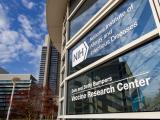Jan 30, 2012 (CIDRAP News) – The battle over dissemination of controversial research on mutant H5N1 avian influenza viruses continued in a flurry of commentaries and media letters in recent days, covering the full range of issues from the potential public health benefits to scientific censorship and the risk of bioterrorist exploitation of the findings.
Over the weekend, the New York Times published a collection of letters by eight experts, keynoted by Dr. Thomas Inglesby, director of the Center for Biosecurity at the University of Pittsburgh Medical Center, who favors withholding details of the findings and halting any further research along the same lines.
The letters were preceded by several commentaries in medical journals last week from partisans on both sides, including Inglesby, and at least one writer somewhere in the middle.
The controversy focuses on research reports under review at Science and Nature, both of them dealing with mutant H5N1 viruses that can spread among ferrets by the airborne route.
The National Science Advisory Board for Biosecurity (NSABB) recommended in December that the journals delete key details before publishing the papers, out of fear that publishing the full data could lead to the unleashing of a very dangerous virus by bioterrorists or through a lab accident. (Disclosure: Michael T. Osterholm, PhD, MPH, director of the University of Minnesota's Center for Infectious Disease Research and Policy, which publishes CIDRAP News, is a member of the NSABB.)
A statement from the NSABB, prepared in response to questions from the Science and Nature editors, is expected to be published in the two journals this week. The journals, for their part, have indicated they would honor the NSABB recommendation if a way can be devised to provide the details of the two studies to scientists who have a legitimate need for them.
Ron Fouchier of Erasmus Medical Center in the Netherlands led the study under review by Science, while Yoshihiro Kawaoka of the University of Wisconsin and the University of Tokyo led the one submitted to Nature.
In his Times letter, Inglesby, a leading defender of the NSABB recommendation, made points much like those he made in a longer commentary in Annals of Internal Medicine last week. He argued that it's unlikely that the H5N1 studies will pay important benefits for avian flu surveillance and control programs or for developing vaccines against H5N1 strains emerging in nature.
"The potential benefits of the research do not justify the potential dangers, so the research should be discontinued," he wrote in the Times. "If allowed to continue, the research should be performed only in pursuit of concrete, urgent goals under international approval and the greatest possible safety conditions."
Vincent Racaniello, PhD, a Columbia University virologist who has been an outspoken critic of the NSABB recommendation, argued in another Times letter that although ferrets are a good model for studying human flu, flu strains behave differently in the two hosts. He also asserted that the H5N1 virus is probably far less lethal in humans than the more-than-50% case-fatality ratio suggests, because many infections have probably not been detected.
In addition, Racaniello wrote, "As a result of this work, we know to look for specific mutations in the same virus as possible indicators of increased mammalian transmission. This is priceless scientific information."
Similar points were made last week by Peter Palese and Taia T. Wang of Mount Sinai School of Medicine in a commentary in the Proceedings of the National Academy of Sciences. "The experiments demonstrate the important finding that aerosol transmission between ferrets can be determined by a relatively small number of mutations that do not significantly change virus virulence," which reinforces the need for continued surveillance of H5 viruses, they wrote.
Palese and Wang also contended that it would be very difficult for bioterrorists to safely generate a stock of dangerous flu virus using "raw sequence information." And even if such a virus were unleashed, existing antiviral drugs and "viable H5 vaccine candidates" would provide some defense against them, they wrote.
Inglesby, in a separate Times letter replying to the other letter writers, allowed that ferrets are not perfect models for human flu, but added, "The principal scientist of the controversial H5N1 experiment said he believes that this engineered virus would spread as well as seasonal flu."
In another Times letter, Dr. Richard Ebright, a professor of chemistry and chemical biology at Princeton University, said the research on lab-generated transmissible H5N1 viruses should be regulated the same way smallpox virus research is regulated. He noted that the World Health Organization (WHO) restricts research on smallpox virus to just two labs with the highest biosafety standards and requires advance approval of all proposed experiments.
In another opinion piece in Annals of Internal Medicine last week, Andrew T. Pavia, MD, a pediatric infectious disease specialist at the University of Utah, called for steering a middle course between halting and censoring the type of research in question and allowing full and free distribution of the data.
"'There are strong arguments for doing these and future studies under the appropriate safeguards and sharing the information gained," he wrote. "Our understanding of the molecular determinants of virulence, species specificity, and transmissibility of influenza viruses is very incomplete."
He said lab biosafety standards for research on easily transmissible H5N1 should be higher than BSL-3, the standard apparently used in the studies in question. Also, though it would be difficult for a would-be bioterrorist to manipulate H5N1, "it would be ill-advised to provide a complete roadmap to the creation of H5N1 with pandemic potential," he wrote.
Pavia further said the risks and benefits of research on highly virulent pathogens should be considered well in advance. Review of such plans by an independent expert group like the NSABB "is an appropriate method and I believe much more acceptable than direct oversight by government authorities."
See also:
Collection of letters in the Times
Inglesby commentary in Ann Intern Med
Palese and Wang commentary in Proc Natl Acad Sci
Pavia commentary in Ann Intern Med

















